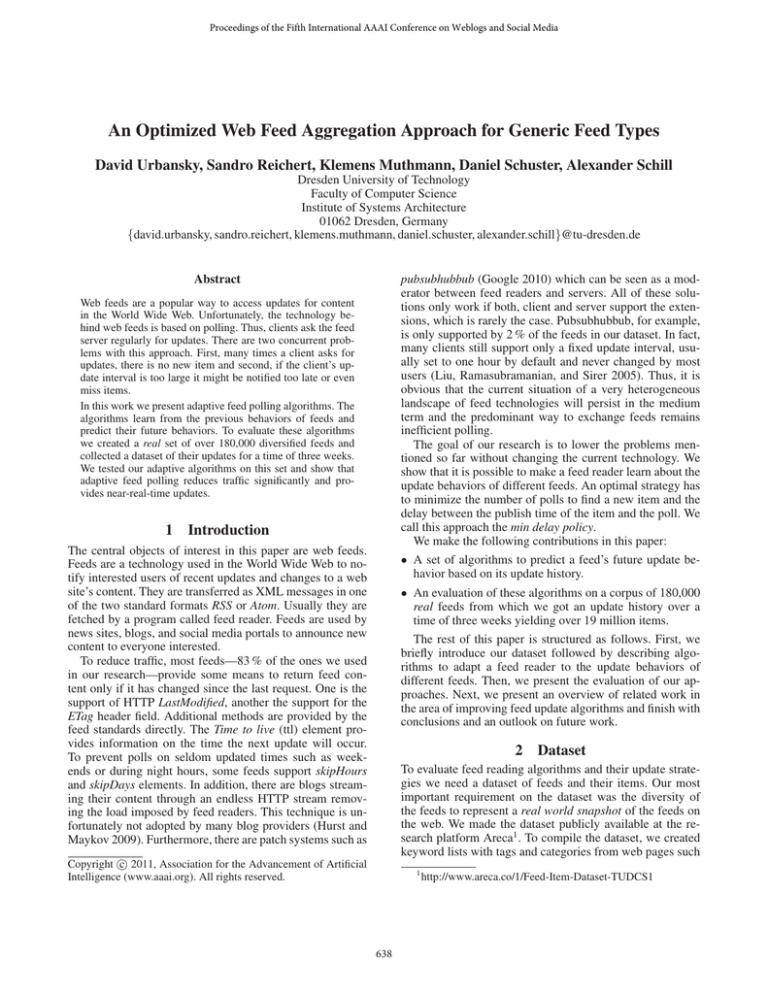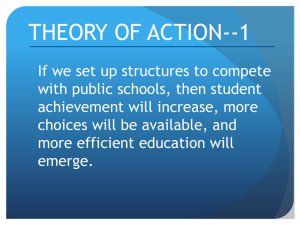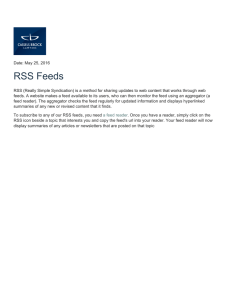
Proceedings of the Fifth International AAAI Conference on Weblogs and Social Media
An Optimized Web Feed Aggregation Approach for Generic Feed Types
David Urbansky, Sandro Reichert, Klemens Muthmann, Daniel Schuster, Alexander Schill
Dresden University of Technology
Faculty of Computer Science
Institute of Systems Architecture
01062 Dresden, Germany
{david.urbansky, sandro.reichert, klemens.muthmann, daniel.schuster, alexander.schill}@tu-dresden.de
pubsubhubbub (Google 2010) which can be seen as a moderator between feed readers and servers. All of these solutions only work if both, client and server support the extensions, which is rarely the case. Pubsubhubbub, for example,
is only supported by 2 % of the feeds in our dataset. In fact,
many clients still support only a fixed update interval, usually set to one hour by default and never changed by most
users (Liu, Ramasubramanian, and Sirer 2005). Thus, it is
obvious that the current situation of a very heterogeneous
landscape of feed technologies will persist in the medium
term and the predominant way to exchange feeds remains
inefficient polling.
The goal of our research is to lower the problems mentioned so far without changing the current technology. We
show that it is possible to make a feed reader learn about the
update behaviors of different feeds. An optimal strategy has
to minimize the number of polls to find a new item and the
delay between the publish time of the item and the poll. We
call this approach the min delay policy.
We make the following contributions in this paper:
Abstract
Web feeds are a popular way to access updates for content
in the World Wide Web. Unfortunately, the technology behind web feeds is based on polling. Thus, clients ask the feed
server regularly for updates. There are two concurrent problems with this approach. First, many times a client asks for
updates, there is no new item and second, if the client’s update interval is too large it might be notified too late or even
miss items.
In this work we present adaptive feed polling algorithms. The
algorithms learn from the previous behaviors of feeds and
predict their future behaviors. To evaluate these algorithms
we created a real set of over 180,000 diversified feeds and
collected a dataset of their updates for a time of three weeks.
We tested our adaptive algorithms on this set and show that
adaptive feed polling reduces traffic significantly and provides near-real-time updates.
1
Introduction
The central objects of interest in this paper are web feeds.
Feeds are a technology used in the World Wide Web to notify interested users of recent updates and changes to a web
site’s content. They are transferred as XML messages in one
of the two standard formats RSS or Atom. Usually they are
fetched by a program called feed reader. Feeds are used by
news sites, blogs, and social media portals to announce new
content to everyone interested.
To reduce traffic, most feeds—83 % of the ones we used
in our research—provide some means to return feed content only if it has changed since the last request. One is the
support of HTTP LastModified, another the support for the
ETag header field. Additional methods are provided by the
feed standards directly. The Time to live (ttl) element provides information on the time the next update will occur.
To prevent polls on seldom updated times such as weekends or during night hours, some feeds support skipHours
and skipDays elements. In addition, there are blogs streaming their content through an endless HTTP stream removing the load imposed by feed readers. This technique is unfortunately not adopted by many blog providers (Hurst and
Maykov 2009). Furthermore, there are patch systems such as
• A set of algorithms to predict a feed’s future update behavior based on its update history.
• An evaluation of these algorithms on a corpus of 180,000
real feeds from which we got an update history over a
time of three weeks yielding over 19 million items.
The rest of this paper is structured as follows. First, we
briefly introduce our dataset followed by describing algorithms to adapt a feed reader to the update behaviors of
different feeds. Then, we present the evaluation of our approaches. Next, we present an overview of related work in
the area of improving feed update algorithms and finish with
conclusions and an outlook on future work.
2
Dataset
To evaluate feed reading algorithms and their update strategies we need a dataset of feeds and their items. Our most
important requirement on the dataset was the diversity of
the feeds to represent a real world snapshot of the feeds on
the web. We made the dataset publicly available at the research platform Areca1 . To compile the dataset, we created
keyword lists with tags and categories from web pages such
c 2011, Association for the Advancement of Artificial
Copyright Intelligence (www.aaai.org). All rights reserved.
1
638
http://www.areca.co/1/Feed-Item-Dataset-TUDCS1
polled too early and should increase u. Calculating the update interval with Equation 1 would yield in no difference
because we still have the same items in the window as the
last time we polled. We therefore add a virtual item on the
timeline at the time p so that ivirtual = p and remove the
oldest one from the window. If we now calculate the update
interval again, we have the chance to increase it and skip
gaps of no postings in the feed.
We can therefore update the old interval by removing the
last item and adding the new virtual item as shown in Equation 2 where un−1 is the current update interval.
as delicious.com and dmoz.org. We used more than 70,000
keywords and combinations of them to query Yahoo and utilized the autodiscovery2 mechanism on the first top 1,000
web pages that were returned for each query. This way we
gathered 240,000 feeds for a wide variety of topics from
220,000 different domains. After polling each feed during
a time span of three weeks and storing each item along with
its timestamp, title, link, number of items, and size, we had
a real dataset of over 19 million items.
3
Update Strategies
In this section we describe four update strategies, three of
them take update behaviors of feeds into account. In the min
delay policy, we try to read a feed as soon as it has at least
one new item and use the following notation for modeling
the problem. u is the update interval, that is, the predicted
time until a new item is posted in the feed. w is the window size of the feed, that is, the number of items that can be
collected at once when looking up the feed. in is the publish time of the nth item and p is the time of the poll. For
all strategies, we limit the poll interval to [2 min, 31 d] to
prevent constant polling and not polling at all.
3.1
un = un−1 −
Fix
Fix Learned
We learn the time between two new items and use it as a
fixed interval for future polls. At the very first poll, we collect all publish dates for the items, calculate the average interval length as shown in Equation 1 and do not change this
interval anymore in the future. If the interval can not be calculated by Equation 1, we set a fixed interval to one hour.
u=
3.3
w−1
1
(in+1 − in )
∗
w − 1 n=1
(2)
Consider the case shown in Figure 1. The feed has a fix
window size w = 5 and periods of more frequent updates
(period 1 and 3) and periods of rare updates (period 2). We
now poll the feed for the very first time at p0 and calculate
the update interval u0 by averaging the update intervals of
the five items in our window w0 . The next poll p1 is therefore p0 + u0 . At p1 , we have again five items in our window
and the new update interval will not change much since the
one new item that we found at p1 and the one that was the
last in our window have similar intervals. After p1 , period 2
of less frequent updates starts. At p2 , we still have the same
items in our window that we had at p1 , so calculating the
new update interval u1 using Equation 1 would not change
anything. We want to increase u, however, and therefore we
drop the oldest item in the window and replace it with the
virtual item (light gray circle). The following polls are farther apart from each other since the update intervals u1 to u8
slightly increase due to fewer posted items. At p9 , period 3
of more frequent updates has started and we must decrease
the update interval in order to lower the delay to new items.
We find five new items in our window and the new, smaller
update interval stays about the same until p13 having only
short delays to each new posted item in the feed.
The simplest algorithm is to poll the feeds in fixed intervals.
We chose one hour and one day as the baseline intervals
Fix 1h and Fix 1d, as these are common change intervals
of websites (Grimes and O’Brien 2008). Furthermore, one
hour is a common default interval in feed readers3 .
3.2
i1 − i0
p − iw−1
+
w−1
w−1
(1)
Moving Average
Figure 1: Changing Update Intervals in the Moving Average
Strategy.
The moving average strategy does almost the same as Fix
Learned but updates the predicted interval u continuously.
The idea is that the last intervals between new items are a
good predictor for the next item. About 30 % of the feeds
in our dataset change their post frequencies quite often. By
continuously averaging the intervals, we can pick up those
frequency changes.
There are two possible observations at each time of poll p.
Either there are new items in the window of the feed or not.
If there are new items, we apply the moving average formula
as shown in Equation 1. If there are no new items we have
3.4
Post Rate
The Post Rate strategy learns the update pattern for each
feed and uses this data to predict future updates. A very
similar strategy has been described in (Adam, Bouras, and
Poulopoulos 2010; Bright, Gal, and Raschid 2006) where it
was called individual-based history adaptive strategy.
The goal is to find the update interval u where we can
expect that a new item has been posted. We use a meticulous post distribution of the feed, that is, we have 1440 time
frames with item post rates for each minute of the day. We
can now calculate the number of expected new items over
2
Autodiscovery mechanism searches the web page’s header for
explicitly stated feed URLs.
3
http://www.therssweblog.com/?guid=20070408105324
639
Moving Average
a certain time span using Equation 3, that is, summing up
the probabilities for a new item in each minute. Our update
interval u is tgoal − tnow with tgoal being a future point in
time so that the number of expected new items is 1 or higher.
Average Delay in Minutes
(3)
t=tnow
Evaluation
1
504
480
456
432
408
384
360
336
312
288
264
240
216
192
168
144
96
120
72
48
0.1
0
300
250
200
0
Fix 1d
10
Time in Hours
4.4
Figure 2: Transferred data volume during three weeks.
4.2
Update Interval Prediction
So far, we analyzed that some strategies adapt their polling
intervals and decrease their average delays. Infrequently updated feeds negatively influence the delay in minutes when
averaging over all feeds. Therefore, Figure 4 compares the
feeds’ real and predicted update intervals, using heatmaps
with log10 scales for all three axis to show how precise the
strategies are for a variety of update intervals. Each dot represents one feed. A perfect strategy would be a straight line
with f (x) = x. Polling with f (x) < x means too often
and f (x) > x results in a delay. We omitted plotting the
baselines Fix 1h and Fix 1d as they were horizontal lines at
1 hr and 1 d respectively. For a big proportion of the feeds in
our dataset, we see real update intervals of more than three
weeks because these feeds were updated infrequently such
as once a month or year.
All figures have 2 minutes / 31 days as the polling intervals’ lower / upper bound in common. Fix Learned tends to
poll too often since it uses the feed’s first window to calculate the interval. The bottom line at two minutes is caused by
feeds that once had a high update frequency but relapsed into
silence. Post Rate performs better than Fix Learned. It has a
lower variance and does not stick at the lower bound. Moving Average’s performance is best. It shows a small variance
at the whole range of real update intervals.
100
24
Transferred Data Volume in Gigabytes
Fix 1h
5
4.3
1000
Fix Learned
10
Figure 3: Timeliness of the update strategies, 300 polls.
First, we compared the network traffic of the five strategies
during a time frame of three weeks. Figure 2 shows the total
transferred amount of gigabytes for each strategy. Polling a
feed once every hour, regardless of its real update behavior,
leads to the highest traffic (Fix 1h). The learning strategies
Moving Average and Post Rate lead to a saving of 90 % compared to the Fix 1h strategy. Interestingly, the Fix Learned
strategy performs a bit better than Fix 1h although it takes
the initial update interval into consideration. We can therefore conclude that feeds change their update behaviors frequently and the update strategy benefits from picking up on
the change. Fix 1d performes slightly better than the learning strategies and leads to the fewest network traffic.
Post Rate
15
Number of Poll with at least one New Item
Network Traffic
Moving Average
20
0
We evaluate the update algorithms for the min delay policy,
where the goal is to minimize lookups but get the next new
item as soon as possible. A good strategy should therefore
minimize the number of polls (and by that also the network
traffic) as well as the delay to each new item. As baselines
we compare the Fix strategies Fix 1h and Fix 1d with the Fix
Learned, the Post Rate, and the Moving Average strategy.
4.1
25
150
4
30
100
postRate(t)
Fix 1h
35
50
newItems(tgoal ) =
Fix Learned
40
tgoal
Post Rate
Overall Comparison
Table 1 shows a comparison of the five update strategies regarding the average delay to finding a newly posted item and
the number of polls to discover one new item. We used two
different averaging modes Feeds and Polls. In the Feeds averaging mode we averaged the measures for all polls that
each strategy made for each feed and averaged them per
strategy. In the Poll averaging mode, we averaged over all
polls of all feeds so feeds with many polls dominate the final result. We can see that, while the Fix 1h strategy has the
smallest delay on average, it also polls most often. The Post
Rate and Moving Average strategy have similar delays, but
the Post Rate strategy polls more often on average.
The best strategy can only be determined in the context
of a real application. If plenty of resources are given and
it is more important to get updates on time, the Fix 1h (or
in even smaller intervals) could be used. We can, however,
Timeliness
Second, we compared the delays for discovering newly
posted items. In Figure 3, we averaged the delays over all
feeds that had at least 300 updates during the creation of
our dataset. This subset contained 1,541 feeds. As expected,
Fix 1h is about 30 minutes too late on average, while Fix 1d
(not shown) reads each new item about 11 hours too late.
Fix Learned performs best with a “constant” average delay
of seven minutes, followed by Moving Average with eight
minutes after 25 polls that have at least one new item. Post
Rate continuously learns from the growing history, but even
after 300 polls, it performs still worse than Moving Average
and Fix Learned. In this discipline, the learning strategies
outperform Fix 1h and Fix 1d which was best in Sec. 4.1.
640
(a) Fix Learned
(b) Post Rate
(c) Moving Average
Figure 4: Comparing real and predicted update intervals.
Mode
Strategy
Delay
PPI
Error
Fix 1h
30m
222.06 6,662
Fix 1d
12h:9m
9.52
6,931
Feeds Fix Learned 54h:33m 41.90
137,139
Post Rate
56h:51m 3.57
12,174
MAV
74h:37m 1.96
8,773
Fix 1h
30m
21.02
179
Fix 1d
12h:25m 1.91
1,423
Polls
Fix Learned 1h:14m
7.77
570
Post Rate
51m
5.88
300
MAV
4m
1.61
6
PPI = Polls Per Item; MAV = Moving Average.
improvements of our adaptive strategies in comparison to
classical and state-of-the-art adaptive feed polling. The algorithms used are Fixed, Fixed Learned, Post Rate, and Moving Average. The Moving Average strategy satisfies these
two requirements best. Efficient polling is an important issue
as long as push mechanisms are not used on a large scale.
In the near future, we will analyse enhancements such as
weighting of items, different history sizes for Moving Average and Post Rate, combinations of algorithms and usage of
feed-specific features such as skipHours and skipDays.
References
Table 1: Comparison of Update Strategies.
Adam, G.; Bouras, C.; and Poulopoulos, V. 2010. Efficient extraction of news articles based on RSS crawling. In International
Conference on Machine and Web Intelligence (ICMWI).
Bright, L.; Gal, A.; and Raschid, L. 2006. Adaptive pull-based
policies for wide area data delivery. ACM Trans. Database Syst.
31(2):631–671.
Google. 2010. pubsubhubbub - Project Hosting on Google Code.
http://code.google.com/p/pubsubhubbub/.
Grimes, C., and O’Brien, S. 2008. Microscale evolution of web
pages. In WWW ’08: Proc. of the 17th international conference on
World Wide Web, 1149–1150. New York, NY, USA: ACM.
Han, Y. G.; Lee, S. H.; Kim, J. H.; and Kim, Y. 2008. A new
aggregation policy for RSS services. In CSSSIA ’08: Proc. of the
2008 international workshop on Context enabled source and service selection, integration and adaptation, 1–7. New York, NY,
USA: ACM.
Hurst, M., and Maykov, A. 2009. Social Streams Blog Crawler. In
ICDE, 1615–1618. IEEE.
Lee, B. S.; Im, J. W.; Hwang, B.; and Zhang, D. 2008. Design of
an RSS Crawler with Adaptive Revisit Manager. In Proc. of 20th
International Conference on Software Engineering and Knowledge
Engineering–SEKE’08.
Lee, B.; Hwang, B.; Mastorakis, N.; Martin, O.; and Zheng, X.
2009. An Efficient Method Predicting Update Probability on Blogs.
In WSEAS International Conference. Proc. Mathematics and Computers in Science and Engineering. WSEAS.
Liu, H.; Ramasubramanian, V.; and Sirer, E. G. 2005. Client behavior and feed characteristics of RSS, a publish- subscribe system
for web micronews. In Proc. of he 5th ACM SIGCOMM conference
on Internet Measurement, 29–34. USENIX Association.
conclude that the strategy which satisfies our two requirements of a short delay and few polls is the Moving Average.
We calculate the Error as shown in Equation 4. The lower
the error the better the strategy. Also, compared to the Post
Rate strategy which has been proposed in literature before,
the Moving Average is simpler as it does not require a post
history to be stored.
Error = Avg. Delay ∗ Polls Per Item
5
(4)
Related Work
Several solutions have already been proposed to the polling
problem. Most similar to our approach are the algorithms
described in (Adam, Bouras, and Poulopoulos 2010; Han et
al. 2008; Bright, Gal, and Raschid 2006; Lee et al. 2008;
2009). All four propose adaptive feed polling algorithms to
address the problems mentioned so far. However, all of them
have different optimization goals and focus on a specific
subset of feeds. Many of them can not adapt to a change
in a feed’s update behavior dynamically. Most are following
the probabilistic Post Rate algorithm, which needs a large
previous update history.
6
Conclusion and Outlook
This paper shows the details of four web feed polling strategies applied to a large corpus of feed update histories. We
collected these histories from more than 180,000 real world
web feeds over a timespan of three weeks and showed the
641









